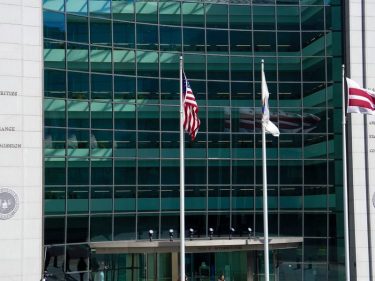Binance $4.3bn fine caps years-long tussle with regulators, Department of Justice
Binance’s legal woes in the US came to a head with the DoJ ordering it to pay $4.3 billion in fines and restitution in exchange for dropping criminal charges.
US regulators and enforcement agencies have been pursuing the world’s biggest crypto exchange by trading volume and its US-based subsidiary, Binance.US, for several years.
This week, those efforts culminated in the US Department of Justice ordering Binance to pay $4.3 billion, among other conditions, to drop a criminal case against it.
This is how the drama unfolded.
2017
July 14: CEO Changpeng Zhao and fellow co-founder Ye Hi launch Binance with the stated aim to become “a world-class crypto exchange.”
2018
January: Binance becomes the world’s top crypto exchange by volume, with Zhao telling Bloomberg that the exchange is adding a “couple of million” registered users every week.September 28: The New York Attorney General refers Binance — as well as fellow exchanges Gate.io and Kraken — to the Department of Financial Services for possible violations of state crypto regulations.
2019
June 13: Binance announces the launch of Binance.US.June 14: Binance’s global exchange bars deposits and trading from US customers on its global platform, and changes its terms of service to state “Binance is unable to provide services to any US person.”September 17: On the eve of the launch of Binance.US, the exchange says it will exclude 13 US states from its services. As of November 2023, that number has dropped to seven.September 18: Binance.US launches.
2020
October 29: Forbes reports that a leaked document known as the Tai Chi document conceive of the creation of Binance.US as an “elaborate corporate structure designed to intentionally deceive regulators.” Zhao and Binance later contested the document, with Zhao claiming he “flatly rejected” the proposal.November 18: Binance sues Forbes for defamation for its October story, stating it contained “numerous false, misleading, and defamatory statements.”
2021
February 4: Binance drops its lawsuit against Forbes without saying why. A judge approves the dismissal the same day.March 12: The Commodity Futures Trading Commission investigates Binance for allegedly allowing the sale of derivatives to US investors, according to Bloomberg.May 13: Bloomberg reports that the Internal Revenue Service, and the US Justice Department are investigating Binance for potential criminal violations. A Binance spokesperson said the exchange had built “a robust compliance programme that incorporates anti-money laundering principles and tools used by financial institutions to detect and address suspicious activity.”September 17: Bloomberg reports that US regulators’ inquiries into Binance are to be expanded to include possible insider trading as well as market manipulation. The review involves CFTC investigators, sources familiar with the matter told the publication.
2022
February 10: Binance buys a $200 million dollar stake in Forbes through a publicly traded special purpose acquisition company just a year after the exchange dropped its defamation lawsuit, Forbes reports.June 5: The US Securities Exchange Commission opens a review into Binance’s BNB token. The review focuses on BNB’s role in Binance’s launch as part of an initial coin offering, an event the agency scrutinises as a potential unregistered security sale.June 13: Jeffrey Lockhart, an investor who lost money in the Terra collapse in May 2022, sues Binance.US for falsely marketing Terra USD as a safe asset ahead of the stablecoin’s collapse, Reuters reports. “These assertions are without merit and we will defend ourselves vigorously,” a Binance spokesperson tells Reuters.September 22: CoinDesk reports Binance has hired several lawmakers including a former US Senate Finance Committee chairman to run a board of advisors to navigate regulatory hurdles worldwide.November 6: Zhao says in a post on Twitter, now X, that Binance will liquidate its holdings in the FTX exchange’s FTT token. The token’s price drops sharply, and begins a liquidity crisis for FTX.November 8: Zhao announces plans to acquire FTX to help its “significant liquidity crunch.”November 9: Binance pulls out of the deal to buy FTX, and within days the exchange enters bankruptcy.November 14: Zhao speaks at a conference in Bali, Indonesia, where the CEO calls for “not just regulators” to protect investors, but for crypto companies to carry their share of responsibilities.
2023
February 8: Binance suspends US dollar deposits and withdrawals for international customers. Binance.US tweets that it is unaffected by the move.February 13: The New York Department of Financial Services orders stablecoin issuer Paxos to cease minting Binance-branded BUSD due to”unresolved issues related to Paxos’ oversight of its relationship with Binance.”March 1: US senators, including long-time anti-crypto firebrand Elizabeth Warren, publish an open letter to Binance and Binance.US requesting information on its internal operations. In the letter, the lawmakers suggest Binance is “a hotbed of illegal activity.”March 10: The DoJ appeals the court order approving Binance’s deal to purchase Voyager Digital, on grounds that the appeal was too broad, and might impede later attempts at criminal charges or enforcement actions.March 17: Binance responds to Warren’s letter with then-Chief Strategy Officer Patrick Hillmann describing the company’s efforts to come into compliance with regulators. ”Between August 2021 and November 2022, Binance stopped over 54,000 transactions as a result of transaction monitoring alerts,” Hillman writes.March 27: The CFTC sues Zhao, Binance, and its related entities for the alleged offer of unregistered crypto derivatives products, as well as for allegedly telling US customers how to evade compliance controls.March 27: A judge halts the deal for Binance.US to purchase bankrupt exchange Voyager Digital.April 25: Binance.US calls off the $1.3 billion deal to purchase Voyager Digital, citing a “hostile and uncertain regulatory climate.”June 5: The SEC sues Binance and Zhao for allegedly mishandling customer funds, lying to investors and regulators, and breaking securities rules.June 7: Binance.US removes several trading pairs — assets that can be traded for each other — and pauses its over-the-counter trading portal.July 6: The SEC asks the presiding court to grant a temporary restraining order to freeze assets linked to Binance.US’ operating and holding firms. The request alleges several compliance failures, including claims that external companies could secretly access US customers’ funds.July 6: Hillmann verifies reports he is leaving the company, but says he does so “on good terms.” Other executives reported to exit the company around this time include General Counsel Hon Ng and Binance.US’s chief business officer, Yibo Ling, neither of whom comment on their departures.
Apologies for any typos, but I was not expecting to be tweeting about this today.
It’s true that I am leaving @Binance, but I’m doing so on good terms. I continue to respect and support @cz_binance and am grateful for having had the incredible opportunity to work under his…
— Patrick Hillmann (@PRHillmann) July 6, 2023August 28: The SEC files a sealed motion against Binance, which would allow the agency to file documents against it out of the view of the public.September 21: Binance, Binance.US, and Zhao file for a motion to dismiss the SEC’s charges against them.September 30: Yiannis Giokas, senior director of product innovation for Moody’s Analytics, tells DL News that if the DoJ files criminal charges against the Binance, it would have “a cascading effect on tokens or crypto and not necessarily on other products that are used for more straightforward use cases.”October 2: A class action lawsuit against Binance and Zhao says that Zhao’s personal “vendetta” saw him post misleading information that caused FTX’s collapse. “The case is without merit and we will vigorously defend ourselves,” a Binance spokesperson told DL News in an email.October 26: In an open letter, Republican Senator Cynthia Lummis urges the DoJ to wrap up its investigations of Binance and Tether and press criminal charges against them.November 8: The SEC rejects Binance’s motion to dismiss the agency’s lawsuit, and says the motion leans on “distorted” and “tortured” readings of the law.November 15: A judge denies a protective order on the SEC vs. Binance case, which allows the public access to the case. The SEC had sought for the details of the case to be sealed in August.November 20: DL News reports that Marcus Bacchi-Howard, who worked as an institutional client account manager at Binance, had become the latest executive to leave the exchange.November 20: Bloomberg reports that the US Department of Justice is seeking more than $4 billion from Binance to resolve its multi-year investigation into the company.November 21: The DOJ announces that Binance has agreed to pay a $4.3 billion fine to settle criminal charges against the exchange. CEO and founder Zhao also agrees to step down as CEO and plead guilty to violations of the Bank Secrecy Act, as well as pay a $50 million fine.
This is an evolving story and we will update it as we learn more.
Tyler Pearson is a Researcher at DL News. If you’ve got a tip on Binance or another story, please reach out at ty@dlnews.com.




